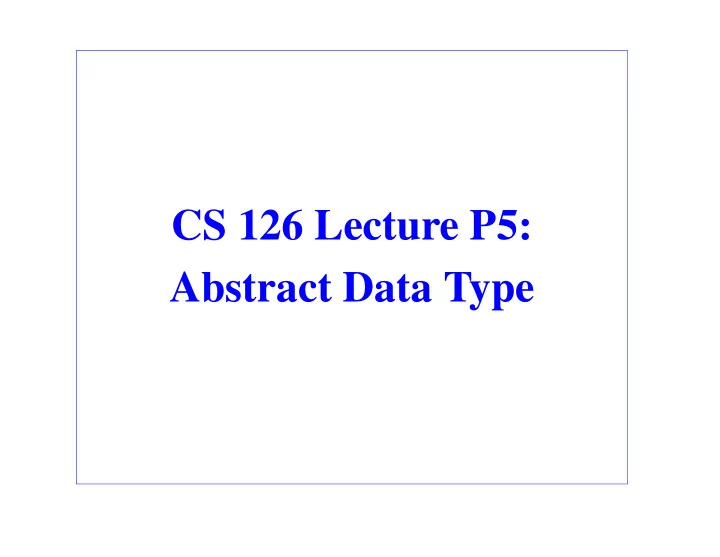

CS 126 Lecture P5: Abstract Data Type
Outline • Introduction • Stacks (and queues) • Stack and queue applications CS126 6-1 Randy Wang
Data Type and ADT CS126 6-2 Randy Wang
Interface, Implementation, and Client Im plem entation Volum e C hannel Interface C lient CS126 6-3 Randy Wang
Advantages of ADT CS126 6-4 Randy Wang
“Non-ADTs” interface: typedef struct {int p; int q;} Rational; client: Rational a; a.p = 3; Non-ADT interface: typedef struct {int p; int q;} Rational; ADT void setRationalP(Rational *r; int x); implementation: void setRationalP(Rational *r; int x) {r->p = x;} client: Rational a; setRational(&r, 3); CS126 6-5 Randy Wang
Outline • Introduction • Stacks (and queues) • Stack and queue applications CS126 6-6 Randy Wang
Stack and Queue Definitions CS126 6-7 Randy Wang
Interface, Implementation, and Client Im plem entation (stack.c) #include Volum e C hannel Interface (stack.h) C lient (m yprog.c) #include • “Client” needs to know how to use the “interface” • “Implementation” needs to know what “interface” to implement CS126 6-8 Randy Wang
Post-increment: s[N] = item; N+=1; Pre-decrement: N-=1; return s[N];
Index of 1st empty slot Time
Opposite of malloc : gives memory back to computer
Demo Linked List Stack CS126 6-13 Randy Wang
for array
Outline • Introduction • Stacks (and queues) • Stack and queue applications CS126 6-15 Randy Wang
infix: a + b postfix: a b + infix: 9*16^4 + 7*16^3+5*16^2 + 3*16^1
number of inputs to main array of input strings number of characters in string for each character in the string pop two items, add them up, and push result back deal with digits: pop the previous digits, multiply the number by 10, add the new digit, and push the partial answer back.
Demo Postfix Calculator CS126 6-18 Randy Wang
“First Class” ADTs { { Stack s1, s2; ... s1 = stackInit(); s2 = stackInit(); stackInit(); ... ... stackPush(s1, 5); stackPush(s2, 8); stackPush(5); } } • So far, only one stack (or queue) per program • “First Class” ADTs - An ADT that is just like a built-in C type - Can declare multiple instances of them - Pass specific instances of them to the interface functions as inputs CS126 6-20 Randy Wang
Take one element from the T queue at a time, add it to the A queue, and repeat until the T queue B is empty. (Not most efficient.)
Conclusion • ADT is one of the most important concepts for managing software engineering complexity • Learn to identify the possible use of ADTs in a program • Learn the proper decomposition and encapsulation using interface and implementation files CS126 6-22 Randy Wang
Recommend
More recommend